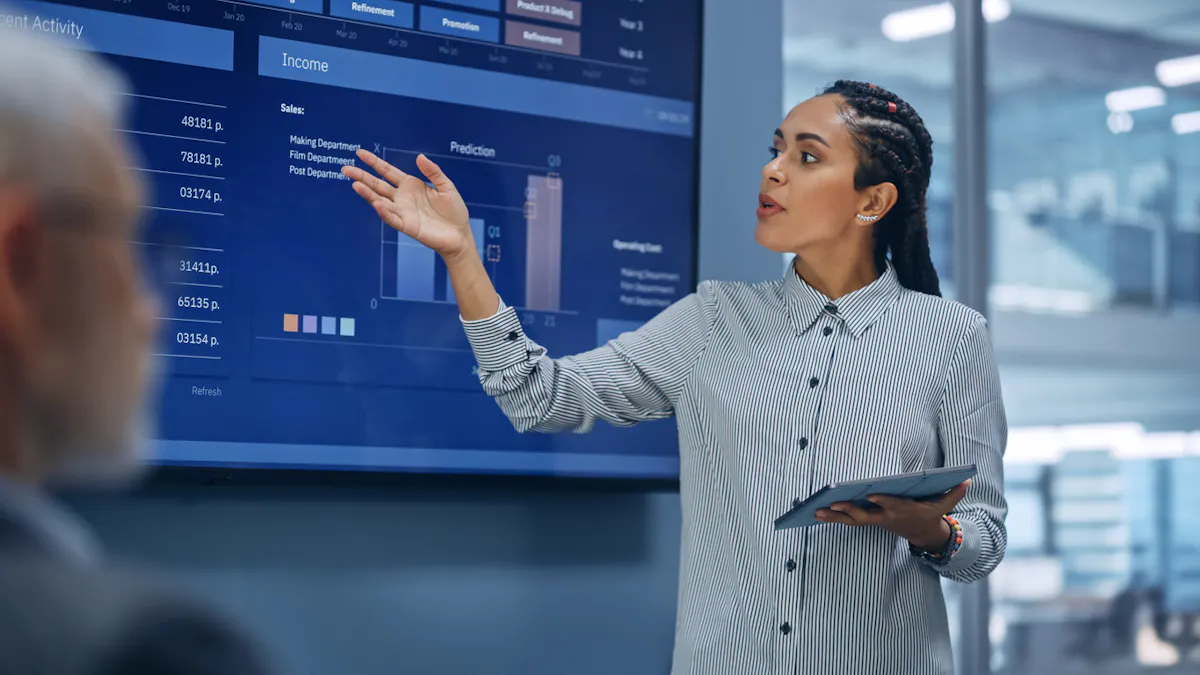What Is Data Visualization? Definition and Overview
Data visualization simplifies a crucial process in today’s business environment: helping stakeholders interpret data to make decisions based on that analysis.
MicroStrategy, an analytics platform, reported in 2020 that 94% of companies said data and analytics were critical to their growth. More than half of companies (57%) said they relied on data to inform their strategy and changes.
As the volume of data produced and consumed globally rapidly increases, data analysis can be challenging.
After all, the World Economic Forum projects that the use of data will increase to 175 zettabytes (150 trillion gigabytes) by 2025, compared with 33ZB in 2018. To illustrate the magnitude of 175ZB of data, the organization examines what even 1ZB represents: If each bit of data within that 1ZB were the size of a coin 1/10th of an inch thick, a stack of those bits would stretch 2,500 light-years.
To help corporate and organizational stakeholders make sense of all that information, data analysts often help to identify the most relevant data before illustrating it in the form of graphics such as animations, charts, and infographics. This practice, called data visualization, is what makes it easier for businesses to analyze the information and use their findings to guide decisions about everything from marketing messaging to product development.
Effective data analysis training incorporates lessons on data visualization. This data analysis skill, a critical component of professional analytics certifications, helps in uncovering and sharing the knowledge and trends that can guide a business or organization toward reaching its goals.
Data Visualization: What Is It?
In the initial stages of analysis, data visualization helps analysts see the structure of the data. Data visualization also assists analysts in identifying trends and similarities within the data. Additionally, the easy-to-consume graphics that data visualization uses help analysts tell the story of the data to organizational decision-makers.
If giving structure to unorganized information to uncover insights is what data analysts do, then data visualization is what makes their work clearer and more actionable. Data visualization helps make large volumes of data useful to businesses by organizing and presenting the conclusions that data analysis yields.
Conveying insights gleaned from data is critical in today’s business climate, which supported an estimated $274 billion in data and business analytics services revenue globally in 2022, according to market and consumer data platform Statista.
Many companies track raw data from various sources and share it through graphics—often in real time—to stay abreast of activity and trends. Companies rely on the visualizations to:
Understand data quickly, compiling large volumes of information into clear images that simplify data-driven decision-making
Identify emerging issues, providing a quick source of information that can uncover trends to guide quick action
Make connections, offering a clear way to show correlations between different types of data
Share information, making complex data easy for everyone from data professionals to corporate leaders to consume and understand
Uncover fraud, revealing suspicious patterns in data that can point to unauthorized access and manipulation
Retain customers, identifying trends in product use to guide suggestions to consumers about future purchases and actions
At Netflix, for example, data visualization not only helps the video streaming service tailor its programming to viewers’ interests, but also drives its marketing plans, app features, and pricing. Another streaming service, Spotify, captures listener data and portrays it through illustrations, and it shares those visualizations with subscribers to reveal their individualized listening habits through its Spotify Wrapped feature.
Benefits of Data Visualization
Companies are increasingly embracing the value of data visualization. Fortune Business Insights, a provider of market research data, estimates that the market for data visualization services will be $19.2 billion by 2027, up from $3.8 billion in 2019.
Another representation of what data visualization means to analysts and companies is the rise of organizations granting professional certifications in data analytics, such as the Amazon Web Services (AWS) Certified Data Analytics - Specialty. The exam to become an AWS certified data analyst includes a section on data visualization.
Data visualization offers analysts and the organizations they work for a host of benefits. Below are some of its advantages.
It’s Visual.
Data visualization relies on an approach to consuming and sharing information that often aids in quicker learning and in retention. For example, in a 2022 presentation to attendees of an Artificial Intelligence in Education (AIED) conference, researchers discussed their study of students who had access to visual representations of trends in their progress and behaviors. This visualization led to enhanced learning and engagement.
It’s Accessible.
Visual representations of data can help in uncovering important knowledge for data analysis experts and non-experts alike. By having access to graphics that clearly illustrate relationships between different sets of data and reveal ongoing and emerging trends, employees and their leadership can make informed decisions that guide a company’s future.
It’s Efficient.
The ability to quickly consume and analyze data not only encourages employees and executives to rely on it for decision-making but also increases efficiency. For decision-makers, the time they would’ve spent poring over indecipherable reports can go toward using the data findings.
It Encourages Action.
Easy-to-understand data helps in rapidly pinpointing the activities that are working. This ability to quickly draw conclusions from data allows for fast action; companies can build on practices that are yielding promising results and adjust initiatives that are ineffective.
Types of Data Visualization
Data analysts use many styles of visualization to provide structure to the information they’re reviewing and to share their findings with others. Some common types of data visualization are:
Area charts—Display lines that show changes to data without emphasizing data values
Dashboards—Summarize various high-level data through multiple types of visualization
Fever charts—Illustrate a specific data point’s changes over time
Heatmaps—Highlight data points in colors representing cooler or warmer temperatures to illustrate their level of importance
Infographics—Present complex sets of data in easy-to-understand text and images
Line charts—Connect data points with lines to show their changes
Population pyramids—Represent groups’ ages and genders by stacking bar graphs
Scatter plots—Use dots to show the relationship between two variables in a set of data
Tables—Present data in rows and columns
Treemaps—Represent data’s value through the use of rectangles of various sizes
Present a Clearer Data Analysis Picture
With the growing amount of data available—and companies’ reliance on the knowledge it reveals as they make decisions—data visualization is what makes it easier to organize information and report on it. If you want to build this critical data analysis skill and many others that can give you an edge in the field, explore the live online Fullstack Academy Data Analytics Bootcamp.
Industry-experienced instructors in the bootcamp facilitate full- or part-time training that requires no prior experience and takes only 10 to 26 weeks to complete. You’ll learn up-to-date and in-demand data analysis techniques and technologies, and you’ll set yourself up to pursue digital visualization certifications through Tableau software and the AWS cloud platform.
Discover how the live online Fullstack Academy Data Analytics Bootcamp can help you launch your data analytics career.
Recommended Readings

Benefits of Data Analytics for Your Business

Data Scientist vs. Data Analyst: What’s the Difference?

Types of Data Analytics Certifications
Sources:
AI Data & Analytics Network, “How Spotify Uses Data to Keep You Listening”
Analytiks, “Why Data Visualization Is Important”
Boost Labs, 6 Fascinating Effects Data Visualization Has on Decision-Making
Forbes, “The Future of Analytics Is Invisible”
Forsta, “What Is Data Visualization and Why Use It?”
Fortune Business Insights, Data Visualization Market Size, Share and Industry Analysis
Hevo, “Data Analytics and Visualization: A Comprehensive Guide”
IBM, What Is Data Visualization?
Live Earth, How Data Visualization Helps Businesses Make Better Decisions
MicroStrategy, 2020 Global State of Enterprise Analytics
Netflix Technology Blog, “Analytics at Netflix: Who We Are and What We Do”
Salesforce, Top 5 Advantages of Data Visualization and How to Leverage Them
Statista, Revenue From Big Data and Business Analytics Worldwide From 2015 to 2022
Unscrambl, 6 Inspiring Examples of Data-Driven Companies (Key Takeaways Included)
World Economic Forum, “The World Data Explained: How Much We’re Producing and Where It’s All Stored”



